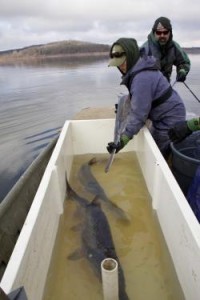MDC tags paddlefish for management study
from The Fishing Wire
Some natural reproduction found in Truman Lake and Mississippi River
Kansas City, Mo. – Missouri Department of Conservation (MDC) biologists will be on the water this fall and winter capturing and tagging paddlefish. The tags, with help from paddlefish anglers, are part of a five-year research project aimed at maintaining a quality paddlefish fishery for anglers. Biologists are also studying natural reproduction in some waters and have determined that some paddlefish spawning is occurring.
MDC crews will be netting and tagging paddlefish this winter for a five-year study to maintain Missouri’s high-quality fishery for the popular sport fish. This is the second year for the study at Lake of the Ozarks, Harry S., Truman Lake, Table Rock Lake and the Mississippi River. The study is aided by anglers reporting information from tags. These fish were netted and tagged in March, 2015.
Photos by Bill Graham, Missouri Department of Conservation
Missouri’s primary paddlefish waters are Harry S. Truman Lake, Lake of the Ozarks, Table Rock Lake, and the Mississippi River. Biologists netted, tagged and released 2,768 paddlefish in those waters prior to the spring, 2015, snagging season. The fish were weighed, measured and given ID jaw tags. Anglers reported tags to MDC, enabling biologists to track fish movement and survival. Anglers reported 234 tags last spring, and 129 of those fish were caught in the upper end of Truman Lake, said Trish Yasger, MDC fisheries management biologist.
The paddlefish snagging season during spring is popular with many anglers. The cartilaginous fish are also called spoonbill because of their long, flat snouts. They feed on plankton and can reach seven feet in length and weigh 160 pounds or more.
The fisheries in Truman Lake, Lake of the Ozarks and Table Rock Lake are supported by stocking young paddlefish hatched and raised in MDC’s Blind Pony Hatchery. Dams have flooded blocked spawning migrations and flooded natural spawning areas on the Osage River system that feeds Lake of the Ozarks and Truman Lake. Paddlefish were introduced by MDC in the James River arm of Table Rock Lake as a new opportunity for anglers. Paddlefish find ample food and grow well as they cruise the large reservoirs feeding on plankton. They make upstream spawning runs in spring, and anglers snag them where they congregate.
Research in 2015 included a study to investigate whether natural reproduction was occurring in Truman Lake. Biologists inserted small 4-inch transmitters into 100 large paddlefish netted and released in the lake. Stationary receivers monitored their movements in the lake’s upper arm and tributaries. In April, 84 percent of the monitored fish moved upstream of Osceola in the Osage River arm. The monitors showed 66 percent of them moving upstream of MDC’s Taberville Access in St. Clair County. Also, 52 percent of the monitored paddlefish moved further upstream and passed the MDC Old Town Access in Bates County on the Marias des Cygnes River, a primary tributary of the Osage system.
MDC crews sampled for paddlefish eggs and larvae at gravel bars in the upstream areas. A limited number of embryos and larvae were collected above MDC’s Taberville Access boat ramp on the Osage River. Several years ago, paddlefish larvae were also collected in the Marais des Cygnes River, Yasger said.
“We are not sure how much natural reproduction is occurring, if it even happens every year, or if the young actually recruit to harvestable size,” Yasger said. “We have a great paddlefish fishery and don’t believe that the limited natural reproduction is enough to sustain it, so we will continue stocking to maintain the population.”
Still, she said it is heartening that natural reproduction is still occurring in the Osage River system considering that dams block spawning migration paths, historical spawning grounds are flooded, land use changes have affected hydrology and water quality, and the Bates County Drainage Ditch built in the early 1900s cut miles off the Marais des Cygnes River’s channel.
“It’s amazing, the fish are still finding a way,” Yasger said.
MDC fishery crews on the Mississippi River using trawling to sample fish populations also have collected paddlefish larvae. Natural paddlefish reproduction is occurring somewhere along Missouri’s eastern border. In 2016, MDC crews will implant transmitters and track 70 paddlefish to monitor spawning in the Mississippi River and tributaries.
For more information on paddlefish in Missouri, visit http://mdc.mo.gov/discover-nature/field-guide/paddlefish.
